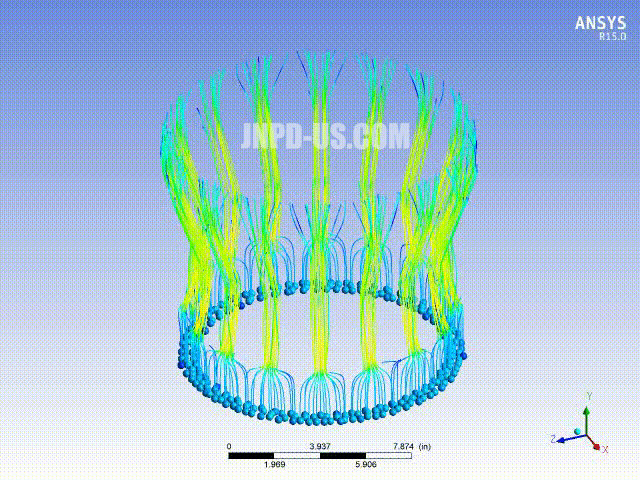What is Computational fluid dynamics (CFD)?
Computational fluid dynamics (CFD) is a branch of fluid mechanics that solves and analyzes fluid flow problems using numerical analysis. It is founded on the Navier-Stokes equations, which describe fluid motion. Fluid movement, heat and mass transport, chemical reactions, and other phenomena are all predicted using CFD.
How CFD is used in industries?
CFD is an effective method for simulating fluid movements and heat transfer. It is employed in numerous industries including as aerospace, automotive, chemical, electronics, energy, marine, and medical.
In aerospace, CFD is used to study the aerodynamic performance of aircraft, spacecraft, and missiles. CFD can also be used to simulate aeroelasticity, which is the interaction between aerodynamic forces and the structural dynamics of an aircraft.
CFD can be used in the energy industry to study the flow of fluids in power plants and other large energy facilities. It can be used to optimize the performance of turbines, pumps, and other components. In the marine industry, CFD is used to design and optimize ship hulls, propellers, and other components. It can also be used to study the flow of water around structures such as dams and bridges.
In the automotive industry, CFD is used for the design and optimization of vehicle components such as the engine, the exhaust system, and aerodynamic body components. It is also used to study the flow of air through the vehicle’s interior, which is important for occupant comfort.
CFD is also used in the medical industry to simulate the flow of blood through the human body, which is important for understanding cardiovascular diseases. It can also be used to study the flow of air in the lungs, which is important for understanding the respiratory system.
Example of a CFD analysis in Oil & Gas industry.
The flow analysis of the wellhead casing hanger anulus port is shown below. While drilling a well, drilling fluid will flow from below to above through side ports on the casing hanger. Engineers can use this research to determine the flow path of drilling fluid, pressure change due to port size, and erosion effect that may damage the casing hanger. Using the information provided above, engineers can optimize the port design of the casing hanger and make drilling fluid flow more efficient to carry out debris, transmit heat, and circulate fluid .


Does Computational Fluid Dynamic yield reliable results?
Yes, CFD can yield reliable results when used correctly. CFD is a powerful numerical technique used to simulate fluid flow and other related phenomena. When coupled with accurate physics models and a robust numerical scheme, CFD is capable of producing reliable results. To accurately set up the boundary condition and choose equations, the user must have basic fluid mechanics expertise. CFD is considered an advanced skill for engineers and is more difficult to operate than FEA.
Basic Step for conducting CFD analysis:
1. Prepare the Model: The first step in conducting a Computational Fluid Dynamics (CFD) analysis is to prepare the model of the system. This includes defining the geometry, material properties, boundary conditions, and other parameters of the system.
2. Mesh the Model: The second step is to construct a mesh of the model. This is done by dividing the model into small elements, or cells, with the size of the cells depending on the accuracy desired.
3. Solve the Problem: The third step is to solve the problem. This involves using numerical methods to solve the equations of motion for the system.
4. Analyze the Results: The fourth step is to analyze the results. This involves looking at the pressure, velocity, and other flow variables over the model and interpreting the results.
5. Validate the Results: The fifth step is to validate the results. This involves comparing the results of the CFD simulation to experimental data or other methods of analysis. This can help to ensure that the results are accurate and reliable.
How you Learn CFD?
In a future article, we will provide free training to assist you to master basic skills.
Hey! Quick question that’s completely off topic.
Do you know how to make your site mobile friendly?
My site looks weird when browsing from my iphone 4. I’m trying to find a theme or plugin that
might be able to resolve this issue. If you have any recommendations, please share.
Many thanks!
Pretty section of content. I just stumbled upon your weblog and in accession capital to assert that I acquire actually enjoyed account your blog posts.
Anyway I’ll be subscribing to your augment and even I achievement you access consistently
rapidly.
It’s hard to find educated people about this topic, but you
sound like you know what you’re talking about! Thanks
Thanks for your practical advice on what is normally an overlooked topic.
Can I link this with my people?
I think the admin of this site is truly working hard in favor of his site, as here every data
is quality based material.
TY for this article, it is quite useful to me! Way
better written than other bloggers out there.